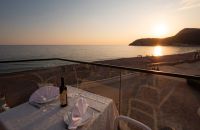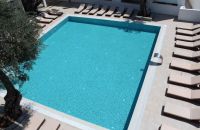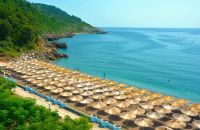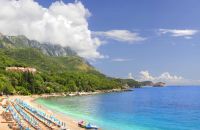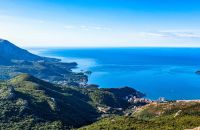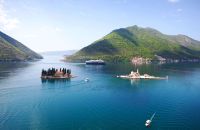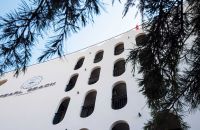TRIPS AND EXCURSIONS
Boka Bay
Boka Bay, a UNESCO cultural heritage site, is undoubtedly most impressive when experienced from the sea. Thanks to its unusual appearance, it is often called the southernmost fjord in Europe, but in fact, Boka Bay is a submerged canyon. The bay consists of 4 smaller bays - Tivat Bay, Herceg Novi Bay, Risan Bay, and Kotor Bay. The narrowest part of the bay, the Verige strait, divides it into an inner and outer part. Boka Bay exudes an unusual calm and tranquility. A boat ride will take you through a unique and picturesque nature, turbulent history, and enchanting architecture.
Skadar Lake
Discover the magic of Skadar Lake, a national park in Montenegro, by enjoying a boat cruise with experienced guides from our tourism agency.
On this excursion, the largest freshwater reservoir in the Balkans, Skadar Lake, will welcome you to Montenegro.
Skadar Lake is located on the territory of two countries, Montenegro and Albania, and is a very important historical and natural center for Montenegro. Since 1983, the lake has been a national park, and since 1995, it has been listed on the Ramsar List of Wetlands of International Importance. Skadar Lake covers an area of 400 km² and offers a multitude of nature activities: bird watching (it has been established that Skadar Lake is a habitat for over 270 bird species), vineyards, boat rides, gastronomy, and much more.
Tara River
Tara is the longest river in Montenegro, measuring 158 km, and one of the most beautiful and challenging rivers in Europe and the world, with an 80 km long canyon that is among the deepest canyons in the world (1,300 m), second only to the Grand Canyon, but undoubtedly the most beautiful. It is formed by the confluence of two small rivers, Opasanica and Veruša, beneath the Komovi Mountain. The last 40 km of the river's course are in Bosnia and Herzegovina, and in several places, it forms the border between the two countries. At Šćepan Polje, it joins the Piva River to form the Drina River. The Tara River and its canyon are a protected area on UNESCO's World Heritage List, meeting three conditions (only one of which was required) to become part of UNESCO's natural heritage, namely a biological, hydrological, and geological phenomenon.
Tara is particularly attractive with its 69 rapids, where it turns into foam and whirlpools, making it very challenging for tourists. The river alternates between powerful rapids, diverse rapids with deep pools, lagoons, pots, and narrows, rare fords. The water is clean and transparent, with various colors, and the shores are lush, smooth, steep, and challenging. Due to its picturesque and unfavorable relief, the attractiveness of its powerful flow with rapids and springs (about 15 major ones), numerous rapids (with a drop of 4.5 meters per kilometer), the richness of flora and fauna, relict, and endemic species, the Tara canyon is unique and unparalleled in the world. The tumultuous and wild tributaries of the Tara carry a large amount of scattered material, stones, and sand that the Tara accepts, crushes, and scatters along its bed, thus creating beautiful boulder reefs and beaches of finely washed sand. The unique canyon, known worldwide as the deepest and steepest river canyon in Europe, and the capricious mountain river attract many tourists from all over the world. Tara is the wildest, most beautiful, and cleanest river on the old continent, and because of its purity, it is called the "tear of Europe."
Njeguši
Njeguši is the birthplace of the eponymous tribe that played a significant role in history, producing prominent bishops and rulers for the Montenegrin state from the Petrović dynasty. A complex of kinship houses made of cut stone are grouped along the main road that leads from Kotor to Cetinje and back. There, you can find Njegoš's birth house, the Petrović House-Tower, the Rade Petrović House, and the Toma Petrović House.
On the other side of the road, in the same courtyard as Njegoš's birth house, is the house of Duke Mirko Petrović, with a guvno beside it. Njegoš's birth house is rectangular and made of stone, belonging to the type of traditional folk architecture of the stony part of Montenegro, simple and without ornamental elements.
Ada Bojana
Ada Bojana is an island that was created artificially, and according to a popular legend, in 1858 a ship called "Merito" sank at the mouth of the Bojana River into the sea. The ship belonged to Antun Alegreti from Trogir and was commanded by Captain Naporeli. This was a crucial moment for the creation of Ada because there were two smaller islands here in the 19th century, so the wreckage of the ship, along with the islands, retained the river sediment and thus created Ada Bojana.
This triangular-shaped island is washed by the sea on one side and the river on the other two and covers as much as 600 hectares.
Ada Bojana has an incredibly rich flora and fauna, and tourists come here in large numbers to relax and enjoy themselves. What sets it apart from the rest of the coast is the maestral - a wind that is perfect for "kitesurfing."
Many also agree that this is a place that dispels negative thoughts and that a longer stay can restore people's will and strength for new victories. It is adorned with Mediterranean vegetation, which gives it the charm of the Amazon.
Ostrog Monastery
Ostrog Monastery is located on the road from Danilovgrad to Nikšić, below the mountain of the same name, at an altitude of 900m. It was founded by and served as the final home of Vasilije Jovanović, better known as St. Vasilije Ostroški. St. Vasilije followed in the footsteps of the hermit and ascetic Isaija and discovered a cave where Isaija had prayed. In that cave, there is the Upper Church dedicated to the Holy Cross. The Upper Monastery consists of the small church of the Holy Cross, built in 1665, and the Church of the Presentation of the Virgin Mary, whose origins cannot be accurately determined, but tradition says it was founded by hermits who lived before St. Vasilije. Today, the monastery is a kind of shrine and a place of pilgrimage for numerous believers.
Biogradska Gora
Biogradska Gora National Park was established in 1952. Located in the north-eastern part of Montenegro, between the Lim and Morača rivers, in the central part of the Bjelasica mountain, it covers an area of 5,650 hectares.
In one of the last three primeval forests in Europe lies Biogradska Gora National Park. If we venture a little deeper into the mountain, we will come across the most beautiful sight: the emerald hues of the stunning Biogradska Lake. We will quickly realize that everything is in its right place there: the centuries-old forests, the colorful flowers, and the legend of the lake's origin, which has been told since ancient times about fairies who used to dance and sing on the meadow, which is now the lake's shallowest part. That place, where the shallow part of the lake is today, was once a common field for two brothers. In a fight that broke out during the division of grain on the threshing floor, the younger brother killed the older one. Broken by grief, the mother cursed her son, and the force of her curse caused the earth to crack at the spot where the field was, and thus the lake was created. But something remained there, to the measure of fairies - far from public eyes, beautiful and capricious.
Its protection dates back to 1878 when this territory became a Prince's reserve, a gift to the then ruler of Montenegro, Prince Nikola. The landscape is extremely gentle, with a dominant green color due to the vastness of unique forest ecosystems, which alternate with picturesque landscapes with meadow vegetation.
The most significant natural value of this national park is the Biogradska Gora primeval forest, which covers an area of up to 4500 hectares and is one of the last three in Europe.
In the clear and calm turquoise waters, ancient beech trees that surround it and mountain peaks in the distance are reflected. The scene awakens the imagination and leaves an impression of deep mystery, so much so that everyone wishes to remain trapped in that harmony of nature and the dark landscapes where the sun barely penetrates and where the scents of vegetation indicate the enormous diversity of the flora and fauna, the centuries-old guardians of the beautiful Biogradska Gora.










